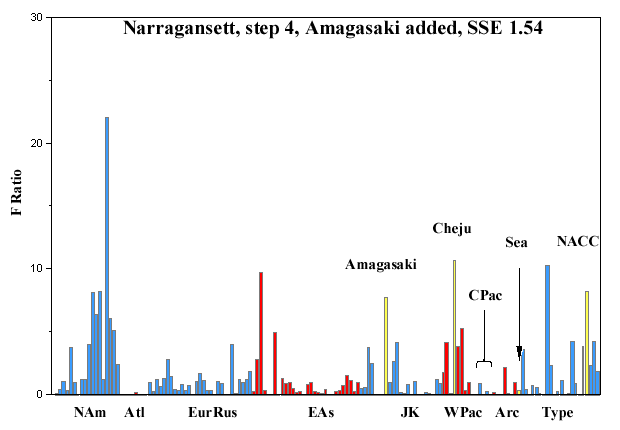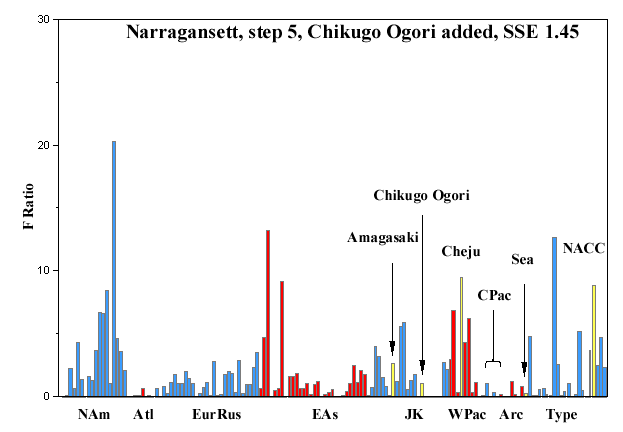
The Japan/Korea Solution for Narragansett
The Japan/Korea thread for Narragansett is shown in red italic in the table below. It quickly proved unacceptable.
| Narragansett, Rhode Island, 22 elements | |||
| Step 0 |
Nothing chosen |
||
| Step 2 | Sea and crust (NACC) chosen, fit 5.65 | ||
| Step 3 | West Point (NY) added, fit 0.88 | Sweden added, fit 1.98 | Cheju added, fit 2.21 |
| Step 4 | Prince George (MD) added, fit 0.32 | Ghent (Belg.) added, fit 1.79 | Amagasaki added, fit 1.54 |
| Step 5 | Sudbury (Ont.) added, fit 0.26 | Lerwick (UK) added, fit 1.62 | Chikugo-Ogori added, fit 1.45 |
| Step 6 | Elms (MD) added, fit 0.23 | Trebanos (UK) added, fit 1.51 | BGoil added, fit 0.81 |
| Step 7 | BGoil added, fit 0.77 | Allen Steam Coal added, fit 0.44 | |
| Step 8 | Allen Steam Coal added, fit 0.53 | ||
We begin by repeating the figure for step 2, so as to show the justification for pursuing a Japan/Korea solution. Note the many sites in Japan and Korea with moderate F-ratios.

Step 3 chooses the highest Japan/Korea site, Cheju. It improves the fit to 2.21, which is poor. Cheju was considered a Japan/Korea site for this thread because it is an island just south of South Korea. (We were giving Japan/Korea the benefit of the doubt.) The F-ratios for North America remain as high or higher than JK.

Step 4 added Amagasaki, the JK site with the highest remaining F-ratio. It improved the fit to 1.54, still unsatisfactory. The high F-ratios of North America remained.

Step 5 added the next-best JK source, Chikugo-Oguri. It improved the fit nominally, from 1.54 to 1.45.

The Japan/Korea solution was not proving satisfactory. We then experimented with adding oil (BGoil), the highest of the type-sources, as step 6. It improved the fit dramatically, to a satisfactory 0.81.

We then supplemented oil with Allen Steam Coal, the highest of the remaining type-sources (step 7), and the fit improved to a very good 0.44, where the thread ended.

This Japan/Korea solution again raises the important procedural question about how much we should depend on type-sources for rescuing bad fits. At the general level, we try to avoid that because the tracer system fundamentally uses place-signatures rather than type-signatures. At the specific level, we already have an excellent place-based North American solution that needs no type-signatures. Thus we reject the European and Japan/Korea threads because they depend on two basic type-signatures each to allow them to compete with the North American solution.